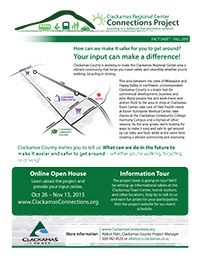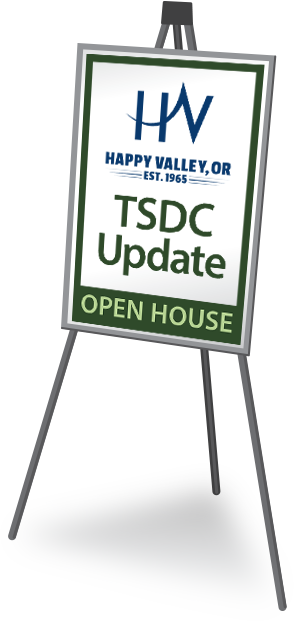Where do you want to go?





= Page includes questions or opportunities for comment.
What are TSDCs?
These are one-time fees paid by developers when they build a new residential or commercial development. The fee covers part of the cost of building transportation facilities to serve new development—like the roads and sidewalks that people use to get where they need to go.
How are the fees calculated?
Development that adds more traffic has higher rates. For example, the low amount of traffic to and from a new single-family home will have less impact than the larger amount of traffic generated by a new grocery store or movie theater. As a result, the fee will be lower for the home.
What is the money spent on?
The City of Happy Valley has a Transportation System Plan (TSP) that guides transportation investments for the city over 20 years. The TSP is updated every five or ten years through an extensive process that allows the public to weigh in on the long list of projects in the TSP. These projects are meant to address long-term travel needs for all modes—walking, biking, driving, freight and taking transit.
The projects on the draft TSDC list are a small slice of projects from the TSP. They include projects that are specifically oriented toward accommodating growth from new development.
What is the Transportation System Development Charges Update?
We are working with a group of representatives from the commercial and residential development community, home builders and engineering firms to help us make recommendations related to the future of TSDCs in Happy Valley. (The final decisions will be made by the City Council.)
This group is considering:
- Developing a new TSDC rate to balance the need to fund transportation improvements while being aware (and considerate) of the constant increase in total costs.
- Identifying criteria for selecting projects that are eligible to be funded with revenue from TSDC fees.
- Ways to simplify the TSDC rate structure, to make it easier for developers to estimate fees.
Why are you doing this now?
Happy Valley recently updated its Transportation System Plan (TSP) that describes transportation projects needed in our community over the next 20 years. The updated TSP put greater emphasis on multimodal travel (for motorists, pedestrians, bicyclists, etc.), and focused on equity, accessibility, health and other goals. We now need to update our TSDC system to support the new TSP goals and updated project lists.
We need your feedback.
On the following pages, you can learn about the changes we’re considering and provide your comments. Our working group, staff and elected officials will consider your input as they make decisions about our future TSDC system.
How does a project make it onto the TSDC project list?
The City of Happy Valley went through a process to refine a draft list of TSDC projects. We began with the list of projects on the City’s 20-year Transportation System Plan (TSP), which includes 37 projects with a total cost of $148 million. We then applied a set of baseline criteria to identify the projects that:
- Increase CONNECTIONS to daily needs and services, and improve vehicle MOVEMENT by reducing congestion at intersections
- Create a direct connection from a highway or other major roadway, or is located in or near a current or future EMPLOYMENT AREA.
- Improve SAFETY on roads.
- Be COST-effective and
- Help implement LOCAL land use or development plans.
The resulting draft TSDC project list contains 32 projects with a total cost of $129 million.
Download the Happy Valley Draft TSDC Project List (pdf, 495kb)
Map Legend
| Project |  | Project List Menu | |
 | City Limits |  | View Full Screen |
Explore the map below to learn about the 32 projects on the draft TSDC project list. Then answer the questions below.
Questions
Specific rates or general categories?
Currently, Happy Valley has 94 separate rates. Reducing the number of rates would make it easier for developers and community members to identify the correct rate, but general rates could change the amount paid for different types of development.
We can use the current approach, or we can reduce the number of rates. The table below briefly describes each option and gives an example of the associated TSDC rate for three typical development types.
Please answer the questions below to give feedback on the option you prefer.
Option* | Explanation | Fee (Based on current cost per trip**) | ||
Single- Family Home | Specialty Retail (5,000 Sq. Ft) | Bank (1,500 Sq. Ft) | ||
1. No ChangeRetain specific land use rates. | Keep the current practice; adopt rates for specific land uses for new development types. This requires staff review of a change of use permit to identify changes in traffic; changes can trigger a charge if additional traffic is generated by the proposed development. | $7,682 | $99,055 | $132,701 |
2. ReductionReduce land use rates by removing those with less than four studies available that estimate traffic rates. | Adopt specific land use rates for new development types, but eliminate rates when fewer than four traffic studies support the amount of traffic generated for a single type of development. This requires staff review of a change of use permit to identify changes in traffic; changes can trigger a charge if additional traffic is generated by the proposed development. (Reduces number of rates by about 10%.) | $7,682 | $99,055 | $132,701 |
3. Consolidation by TypeConsolidate land uses into similar use categories. | Combine similar land use categories (e.g., different types of commercial in one category, different types of industrial in another, etc.), and average the traffic generated by the similar uses to establish a broad category rate that generally matches the proposed development. This would reduce the need to capture fees on a change of use if the proposed use falls within the same use category. (Reduces number of rates by about 50%. This change may cause higher traffic generating uses to pay less and lower traffic generating uses to pay more.) | $7,682 | $108,229 | $132,701 |
4. Consolidation by ZoneConsolidate land uses based on land use zoning. | Combine land uses based on allowed uses within the land use zone in which the development is located; average the traffic generated by the uses to establish a rate for that zone. This would eliminate the need to capture fees on a change of use if the proposed use is also a permitted use in that zone. (Reduces number of rates by about 80%. This change may cause higher traffic generating uses to pay less and lower traffic generating uses to pay more.) | $7,682 | $152,841 | $45,852 |
* Under any of the options above, an applicant may choose to pay for a traffic study to gather traffic data for a use similar to the development proposal. Studies must comply with the ordinance in effect at the time.
** Fees differ from the current SDC Fee schedule due to updates to trip rates for land use categories.
Questions
How do we determine traffic created by new development?
Fees are based on the amount of traffic a development is likely to create. We are considering two options for determining the amount of added traffic:
- Average daily trips to and from a site - Charge fees based on the total amount of traffic that a land use generates in a full day.
- Afternoon rush-hour traffic - Traffic is heaviest during weekday afternoon commute times. Road improvements are often needed to accommodate these high traffic flows. Because of this, many communities use afternoon rush-hour traffic to assess fees.
Using afternoon rush-hour traffic as the basis for the fees would mean higher rates for uses with more traffic during afternoon commutes. Here are some examples of how traffic impacts could differ under the two options.
| Adjusted Trips to and from a site* | ||
Land use type | Option 1: | Option 2: |
Single-family home | ≈ 10 trips | ≈ 1 trip |
Specialty retail (5,000 Sq. Ft.) | ≈ 123 trips | ≈ 9 trips |
Medical Office (5,000 Sq. Ft.) | ≈ 66 trips | ≈ 5 trips |
School (10 classrooms with 25 students per class) | ≈ 128 trips | ≈ 37 trips |
* Adjusted for pass-by trips
Questions
Next Steps
- Staff will meet with the TSDC group to review public input and develop recommendations.
- Recommendations will be presented to the City Council.
- City Council will hold meetings to review, gather input, discuss and take action on the recommendations.
For More Information
- Visit the project website: ClackamasConnections.org
- Contact Michael Walter, City of Happy Valley, 503-783-3839 or michaelw@happyvalleyor.gov
- Sign up for project updates below.
This site is no longer accepting comments, but you can provide feedback through the project website.
Final Questions
Mailing list (Optional)
Provide the following optional contact information if you would like to be added to the project mailing list.
Demographic Information (Optional)
This project is requesting demographic information to evaluate the effectiveness of public outreach activities. The identity of individuals is kept confidential. The results are reported as totals only, and used solely to help improve future community engagement. Providing this information is voluntary and optional.



